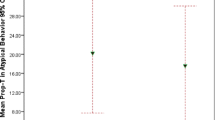Abstract
“Tummy time” is an activity for infants to develop muscle tone; however, it often evokes crying and non-compliance. The current study investigated two interventions for an infant to a) increase elevated head behavior, and b) decrease negative vocalizations. The study compared the effects of a preferred stimulus with or without maternal attention on infant behaviors during tummy time. The addition of maternal attention produced more positive outcomes:
-
The science of behavior analysis can be used to treat a broad range of socially significant behaviors like infant behavior during tummy time.
-
Preference assessments can be used with infants to identify potentially reinforcing stimuli.
-
The continuous provision of a preferred stimulus during tummy time may help infants to increase positive behaviors and decrease problem behaviors.
-
Parent attention may have an added benefit to a treatment package for typically developing infants.

Similar content being viewed by others
References
Graham, J. M. (2006). Tummy time is important. Clinical Pediatrics, 45, 119–121.
Hagopian, L. P., Rush, K. S., Lewin, A. B., & Long, E. S. (2001). Evaluating the predictive validity of a single stimulus engagement preference assessment. Journal of Applied Behavior Analysis, 34, 475–486.
Kadey, H. J., & Roane, H. S. (2012). Effects of access to a stimulating objects on infant behavior during tummy time. Journal of Applied Behavior Analysis, 45, 395–399.
Kuo, Y. L., Liao, H. F., Chen, P. C., Hsieh, W. S., & Hwang, A. W. (2008). The influence of wakeful prone positioning on motor development during early life. Journal of Developmental and Behavioral Pediatrics, 29, 367–376. doi:10.1097/DBP.0b013e3181856d54.
Larson, K., & Teodoro, A. (1990). The effects on contingent music and differential reinforcement on infantile colic. Behaviour Research and Therapy, 28, 119–125.
Persing, J., James, H., Swanson, J., & Kattwinkel, J. (2003). Prevention and management of positional skill deformities in infants. Pediatrics, 112, 199–202.
Thompson, R. H., Cotnoir-Bichelman, N. M., McKerchar, P. M., Tate, T. L., & Dancho, K. A. (2007). Enhancing early communication through infant sign training. Journal of Applied Behavior Analysis, 40, 15–23.
Author information
Authors and Affiliations
Corresponding author
Rights and permissions
About this article
Cite this article
Ortega, R., Fienup, D.M. Effects of a Preferred Stimulus and Mother’s Attention on Infant Behavior During Tummy Time. Behav Analysis Practice 8, 66–69 (2015). https://doi.org/10.1007/s40617-014-0032-1
Published:
Issue Date:
DOI: https://doi.org/10.1007/s40617-014-0032-1




